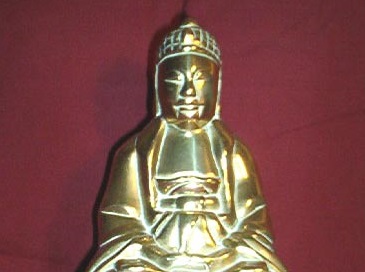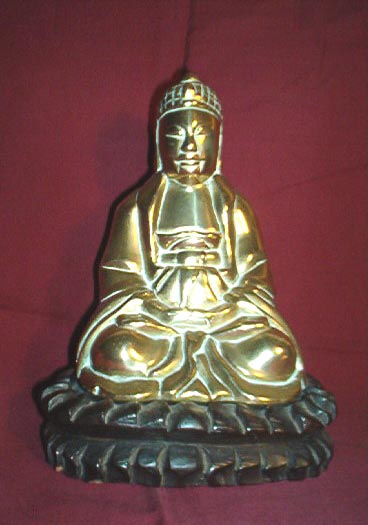
Many people meeting the Vidyadhara for the first time may have felt awkward and out of place. Some may even have felt as deeply ambivalent about the situation and as reluctant to be there as I did. Few, though, can have upped the edginess of the occasion by making him an offering of an Amitabha made of fibre glass. It’s a story that needs a bit of background.
In 1972, a few years before, disappointed by graduate school and unnerved by American culture, I had dropped out and returned to South Africa, sad to say goodbye to friends, but happy and relieved to shake academic fustiness from the mind and the continent’s dust from my feet.
Back in Johannesburg, after a few years’ obligatory hippiedom, I came across the only Buddhist group on the continent, a Kagyu centre which had been set up under the auspices of His Holiness Karmpa. Meeting with these teachings felt highly auspicious — but after several months the woman director began to go off the rails in front of our eyes, quietly but unmistakably transmuting into a full-fledged charlatan.
Somewhat rattled by the experience, I left the group. I was not, though, awake enough to steer away from manufacturing small fibre glass Amitabhas to give to friends. While I was well aware that there was something intrinsically chintzy about the material, in the afterglow of a chemically-altered reality and dazzled by newly-found notions of nothingness, luminosity and absolute truth, it seemed okay to make the objects. Mixing reds, maroons and oranges, adding in gold and copper filings, I worked hard at getting right what I conceived to be the colour of compassion. It seemed to me at the time a form of devotion, but I could never quite suppress the nagging sense that there was something iffy about the whole thing.
Meanwhile, I had become a committed vegetarian, teetotaller and celibate, and had come within a hair’s breath of taking robes. Yet somehow this package of good things didn’t quite do it. It was dawning on me that books and abstemiousness weren’t enough. I had to find a teacher. Much as I tried to avoid the fact, the States seemed to be where the good ones were. A Ch’an group in California, or maybe one of the Zen centres, seemed best. With the recent Johannesburg fiasco fresh in my mind, I would be steering clear of the Kagyu Lineage.
This was in spite of the fact that, my eye having once been caught by the vibrant saffron of its cover, I’d picked up a copy of Meditation in Action (it turned out to be one of the last books I ripped off), had also read Cutting Through Spiritual Materialism, and had begun to have a good sense of the power and eloquence of the Vidyadhara’s teachings. When, arriving in the States and heading back to my old stomping grounds, I found my way to the Boston Dharmadhatu, thinking to transcribe some of his talks to take back to South Africa. But I consciously had no wish to meet the Vidyadhara in person.
At the Dharmadhatu I met Richard McGregor and Chris Pleim who told me of the upcoming Trungpa Lineage Intensive at Tail of the Tiger, or Karme Chöling, as it had recently been named. When they heard that I was quite determinedly not going to go, their jaws dropped—literally, I seem to remember. I think it was this sheer, unfeigned, disbelief that got me. I found myself in Richard’s car, heading with them to Vermont.
With the main shrine room under construction, the Vidyadhara was giving his talks in the dining room. They were as brilliant as I’d come to expect, but there was something else. Unlike the anal, heady, defense-attack mode of the academic seminars I was familiar with, the atmosphere was open and inviting, the sharper the questions the better. More surprising was the pervasive sense of humour. I even caught some of the jokes. Periodically something would happen outside the room—a pot clanging in the kitchen, a dog’s bark, a roll of thunder—which seemed to spark a wave of delighted laughter in the room. It was all a bit bewildering, not at all what I’d expected.
Still, it seemed worth looking into. It also began to feel odd to come such a long way without at least saying hello. So, at the end of a talk, I went up to chat with the Vidyadhara. He seemed genuinely happy to meet me and, after I’d introduced myself, said smilingly: ” My wife’s from South Africa.” When I mentioned the teaching challenges facing me back home, he seemed to suggest that we could discuss them further. Realizing later that the situation was open and that this could be the only chance I had of getting some real advice before heading back to Africa, I requested an interview.
As the time of the interview approached, things got absurdly edgy. Unhappily back in the belly of the yankee dragon, anxious about being among Kagyus again, disturbed by the hard-drinking parties and by some of the most beautiful women I’d seen anywhere, paranoid about the powerful and intimidating environment, everything seemed to be building to a painful point.
In this self-created claustrophobia, even after learning more about who he was, I decided to offer the Vidyadhara one of my home-grown Amitabhas. I’m not sure why. Maybe I felt that, if I could detect some flicker of scorn or repudiation, however subtle, of the Western fabrication with which I was confronting him, I would be justified in making my escape.
Bill McKeever, Karme Chöling’s director at the time, ushered me into the interview room. The Vidyadhara sat in a chair wearing an elegantly-tailored suit. Across the room from him was a simple yet beautiful shrine, at its centre a lovely, and probably very old, brass Buddha. I made three prostrations — probably the first seen in that room in quite awhile – awkwardly offered him my fibre glass object, and sat down on a cushion.

The Vidyadhara graciously accepted the small buddha, asked about its provenance, then placed it gently on his side table. He was kind, helpful, and ordinary, inquiring about the dharma situation in South Africa, offering pointers on my teaching role there, asking about my travel plans. Again I was struck by his simplicity and straightforwardness. There was no grand epiphany, no lights in the sky. As I left the room I felt that I had spent twenty pleasurable minutes with a wise and courteous friend. It also felt as if the dense multi-layers of paranoia had begun to melt, shift, and crack.
An hour or so later Bill and I bumped into each other outside the kitchen. With an amused smile he said “Rinpoche’s so funny.” Still perplexed by a high lama who was a potent source of humour and laughter, but not wanting to appear at a loss, I said “Why?” Bill giggled and said:
“After you left the room, Rinpoche took your Buddha over to his shrine, placed it next to his brass rupa and said: ‘Here’s your brother from South Africa. Now you two sit there and talk to each other.'”
A few days later, after listening to another talk or two, I ate my first hamburger in years, going on to imbibe a hefty dose of grain alcohol – Karme Chöling’s fashionable liquor at the time — following up these cosmic breakthroughs with a brief affair. Around the same time I filled out two application forms, one for Seminary, the other for permanent residence in the United States.











